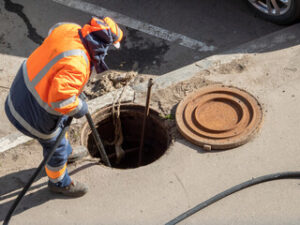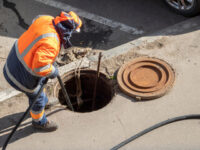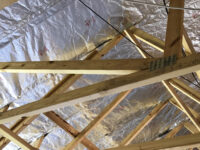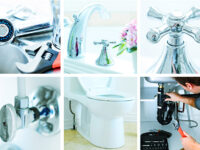Trenchless Sewer Repair
Many homeowners dread the idea of their plumber digging up their yard to fix a sewer line. Trenchless repair at Joe’s Plumbing offers a less destructive and much quicker option.
After hydrostatic or mechanical cleaning, an epoxy-saturated tube (liner) is inserted into the existing pipe. The liner then cures, creating a new structural pipe within the old one.
This method, also called “cured-in-place pipe” (CIPP), involves inserting a liner coated in resin directly into the existing pipe. The result is a brand new pipe inside the old one, which eliminates leaks and protects against future damage from tree roots and corrosion. Your plumber will send a camera down the drain to find out how bad the damage is and what your best options are for repairs. Angi can connect you with plumbers who are familiar with this trenchless technology, so you can feel confident that your repairs will be done quickly and correctly.
Before the lining process begins, your plumber will clean out the damaged pipe with hydro-jetting and then prepare materials. The CIPP liner is made from a rubber bladder filled with epoxy resin that fits inside your damaged host pipe. A specialized winch tool pulls the liner through and expands it, adhering it to your host pipe wall. When it dries, the CIPP liner becomes as strong as your original pipe, stopping cracks and leaks in their tracks.
The liners are a long-lasting solution that can last up to 50 years and resist root intrusion and corrosion. Your plumber will need to create just one access point (usually the sewer cleanout) for this process, which usually takes a few hours. You’ll need to limit your water use during this time and keep children and pets away from the area. Your plumber will inform you of the process beforehand, and they’ll likely ask you to remove items that can’t be moved, like lawn ornaments, potted plants, or toys.
If your pipes are beyond relining, you might need a different type of replacement. A traditional method is pipe bursting, which uses a special nozzle to break apart the old pipes while pulling in a new pipe behind them. The resulting void is then filled with grout to make sure your new pipe is structurally sound and free of holes and cracks. Angi will help you understand your options so you can make the best decision for your home and budget. Often, replacing a broken pipe is the only way to stop sewage backups and other unpleasant symptoms in your home.
Pipe Bursting
Pipe bursting is a trenchless method of replacing old, damaged, or broken sewer pipes. A machine inserts a “bursting head” into the old pipe, which breaks it up and pulls a new, larger-diameter line through its opening. Sewer pros typically use this to replace sewer lateral lines, which connect your home or business to the main line. The new high-density polyethylene (HDPE) piping is durable and won’t rust or corrode.
To begin, a technician finds an entry point and a receiving pit. Then, they clear and prepare the area around the clogged or damaged sewer line. A hydraulic arm is then guided through the clogged or damaged pipe, pulling the replacement pipe behind it as it moves. This “pulls” the bursting head into place, which fractures the old line into small pieces and pushes them outward as it travels. The pulverized debris is then replaced with the new pipe, which takes its place without any further problems.
The new pipe is heat-welded above ground to ensure that tree roots can’t penetrate it, which can cause further damage. Once the installation is complete, another inspection is done to make sure that the repair was successful.
While both of these trenchless sewer repair techniques can be used for many types of repairs, there are certain circumstances in which traditional excavation must be used. These include cases in which there are nearby, vital utilities that need to remain undisturbed or if the old, damaged pipe is too corroded to be repaired with other methods. If you have questions about what trenchless sewer repair techniques are best for your situation, contact a qualified professional to find out more.
Hydrojetting
Unlike traditional methods of drain line cleaning, hydro jetting doesn’t involve digging up your property. It uses a high-pressure water jet nozzle to scour the interior walls of your pipes, blasting away any caked-on layers of buildup and leaving your sewer lines looking like new.
For stubborn blockages that don’t respond to a plunger or snake, hydrojetting is a quick and effective solution. It’s also useful for removing debris that’s causing a backup, such as broken tree roots or other large objects. Hydro jetting can also help to scour rust or corrosion from the insides of your pipes, reducing your risk of pipe collapse and clogs in the future.
The power of the water jet is so strong that it can even cut through concrete, but this technique should only be done by a qualified technician. A professional will use a special head attached to a water hose that is fed into the sewer pipe via an access point or drain on your property. The nozzle on the head is designed to target only the part of the pipe where the clog is located. Once the clog is removed, the plumber will rinse the insides of the pipe with clean water to ensure that there are no small fragments left behind to cause another clog later on.
Aside from removing clogs, hydrojetting can also be used to spot early warning signs of trouble with your sewer or drain line. Regular drain cleaning can reveal issues such as micro-fissures, thinning areas, and rust or corrosion. Identifying these problems with hydro jetting can save you the expense of a costly excavation and repair later on.
Besides preventing sewer line blockages, routine hydrojetting can help reduce odors and improve waste water flow in older homes and commercial buildings. This method of cleaning is especially important for restaurants and other businesses that produce a lot of grease, which can build up on the insides of your pipes.
If you’ve tried using a plunger or drain snake but still find yourself dealing with stubborn clogs, give us a call today. We’ll send a professional technician to your home or business, perform a video inspection, and then hydrojet your pipes. We can get your drains flowing smoothly again in no time.
Inspection
Trenchless technology allows us to do a lot of work underground without digging large trenches. As a result, we don’t have to close off your street or dig up your yard to repair or replace your sewer line. This makes it a much quicker process, and it’s also less expensive than traditional methods.
If your sewer line is clogged, damaged, or destroyed, it’s a plumbing emergency that needs to be dealt with right away. However, you might not want to deal with the disruption that comes with a full excavation. Conventional methods require plumbers to dig up your yard, landscaping, sidewalks, and driveway to access and remove the old pipe and install a new one. Not only is this inconvenient for you, but it can also cost you money to restore and replace your property.
Traditional trenching can also damage the root systems of any trees on your property and cause sagging in the landscape you’ve worked so hard to cultivate. Trenchless sewer repair, also known as no-dig sewer repair, is a better alternative that saves you time and money while keeping your property intact.
No-dig sewer repair is accomplished using two main techniques: pipe bursting and pipe lining. Both of these processes require fewer excavations and can be done in just a few days. They’re also more effective than their conventional counterparts, and they’ll last for decades.
The first step in this trenchless technique is hydrojetting to clear away any stray roots or soil buildup that might hinder the installation of the new lining. Once the pipes are free of obstructions, a technician will insert a camera to view the condition of the old pipe and determine how thick the new lining should be.
For pipes with structural issues like holes, channeling, age deterioration, and scaling, pipe lining is the best option. The installer will inject a high-tech epoxy resin into your existing pipes to create a smooth, strong, and corrosion-resistant new inner lining that’s just as durable as the original pipe.
This method is great for sewer lines with sound structural integrity, but it’s not ideal for clogged, damaged, or collapsed pipes. It’s also not ideal for pipes that run under parking lots or sidewalks. Trenchless pipe replacement is the best choice in these cases.




